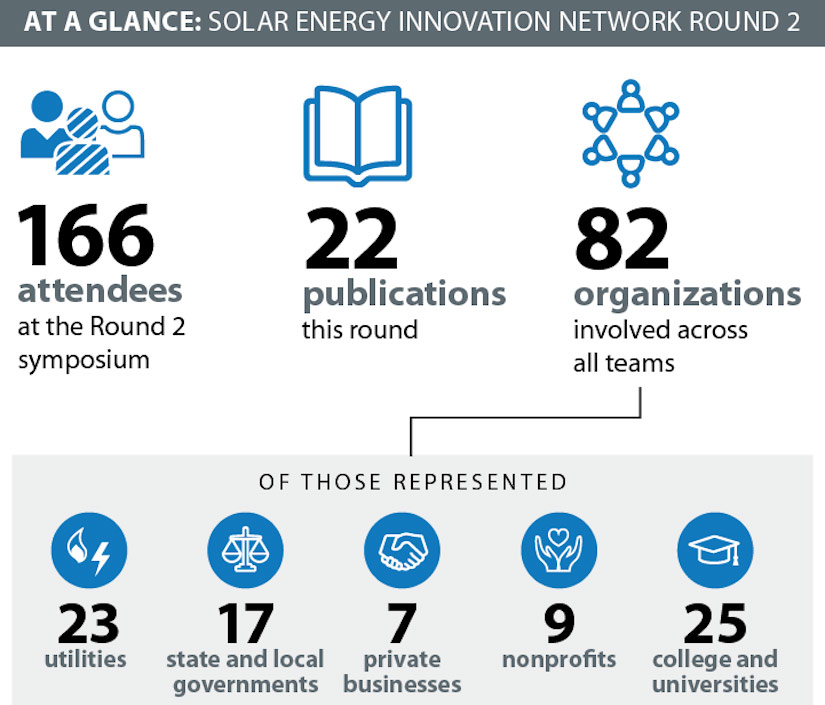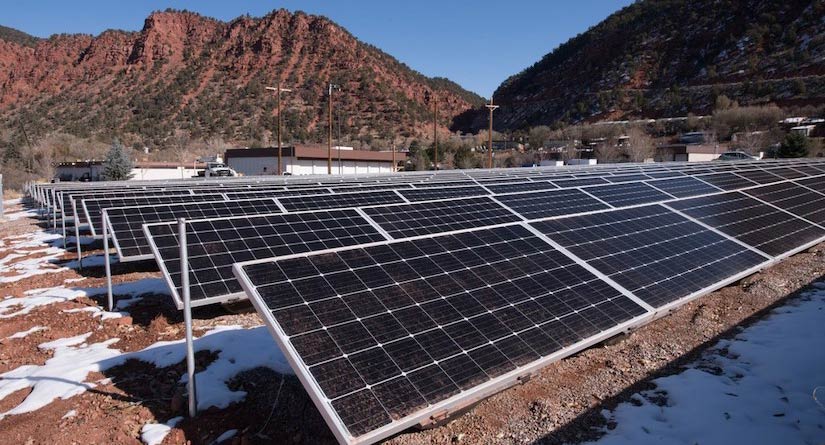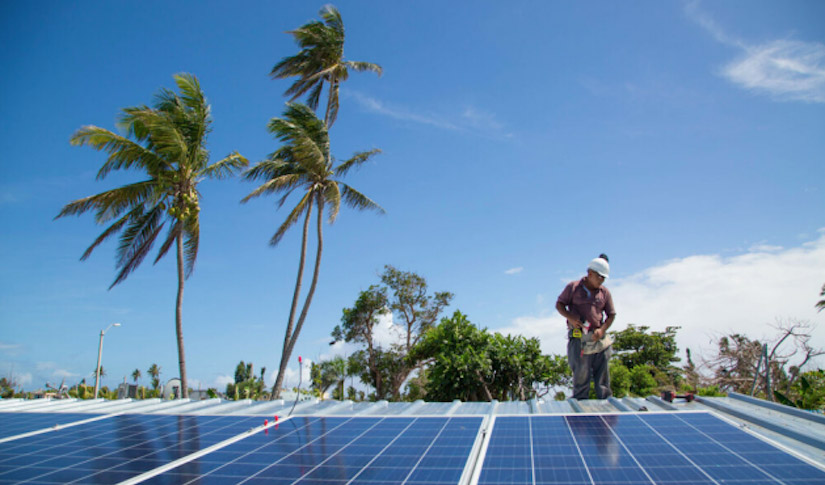A Treasure Trove for Rural and Commercial-Scale Solar Projects
Publications From 8 Teams Capture Insights for Communities Seeking To Harness Resiliency and Economic Benefits of Solar Energy
It takes grace and dexterity to manage the policy and technical challenges of adopting renewable energy while also addressing disaster preparedness—bringing stakeholders to the table at the same time. Eight teams in the second round of the Solar Energy Innovation Network (SEIN) tackled those challenges and more, providing a blueprint for other communities pursuing projects focused on solar-plus-storage, the resilience benefits of solar, and the value of solar in electric distribution systems.
Teams From Across United States Publish Recommendations for New Ways of Adopting Solar
SEIN connects teams of stakeholders that are pioneering new ideas with the resources they need to overcome barriers to solar adoption. Teams collaborated in two separate cohorts in this second round, collectively publishing 22 resources. Each cohort was formed around a theme: solar in commercial-scale settings or in rural communities. Teams collaborated across and within cohorts to develop their ideas in real-world contexts, yielding results that can unlock tomorrow's solar markets. The result is blueprints, analyses, tools, and tip sheets for others facing similar circumstances. These resources are freely available for download: Read below for specific examples.
This recent set of publications wraps up the program's second round, which lasted 15 months. Throughout that time, teams received analytical support from the National Renewable Energy Laboratory (NREL) and Lawrence Berkeley National Laboratory (LBNL) and facilitation support from Rocky Mountain Institute (RMI), along with direct funding from the U.S. Department of Energy Solar Energy Technologies Office, to overcome barriers to adopting solar energy. During workshops, the teams worked closely to identify challenges, formulate and test potential solutions, and validate new models alongside technical advisors from NREL research staff.
"NREL lent their expertise and their passion for innovation and energy equity to our diverse, multi-stakeholder team and helped us to envision technical approaches and a scope of impact that went well beyond our initial project brief," said SEIN participant and Groundswell CEO Michelle Moore.

Severe Weather, Rural Energy Co-Ops, and Solar for Renters Pose Some of the Complexities Teams Addressed
From the dense urban landscape of New York City to the intricate policy landscape of local electric co-ops, the teams in this round covered an eclectic variety of locations with a diverse set of challenges.
In the commercial-scale solar cohort, for instance, the team led by Sustainable CUNY (City University of New York) explained in their project road map that "Urban areas like NYC, which have a large population of renters, are particularly well suited" for community solar projects that offer renewable energy on a subscription basis, but these "projects have stalled at the doorstep of many cities," in part because stakeholders lack economic data to support decisions. Through the Innovation Network, Sustainable CUNY partnered with key stakeholders, including the Real Estate Board of New York (REBNY), to analyze community solar and community solar-plus-storage options, developing tools and resources to provide landowners interested in community solar the support to move forward.
The Clear Sky Tampa Bay team also addressed policy challenges in their Project and Toolkit Overview, with the added layer of severe weather: "Recent natural disasters ... have reinforced the need for reliable power to sustain essential services and critical facilities within communities," they wrote, but siting such facilities can be a tough hurdle. The team developed guidelines to help address such challenges in their Decision Support toolkit and within detailed county use cases (for example, Pinellas County and Hillsborough County, among others).

In the rural cohort, the Solar-Plus for Electric Cooperatives (SPECs) team (representing energy co-ops from Colorado, Georgia, New Mexico, and North Carolina) released an early-stage decision model to help co-ops evaluate potential solar-plus-storage projects. Their SPECs tool addresses the modernization and renewable energy development challenges of serving electricity needs across a mostly rural landscape, including most of the nation's persistently impoverished counties.
Ensuring Solar Helps the Local Community
Teams aimed for local benefits and community input as central themes in these projects. For example, the team in Massachusetts sought planning and financing mechanisms to keep solar benefits within the small communities that typically host large solar arrays. Their step-by-step Community Planning for Solar Toolkit encourages any organization looking to adopt solar energy to identify a wide set of stakeholders, including private residents, so that the community solar plan truly addresses the needs of the community.
Likewise, the Breaking Barriers project team worked withneighborhoods surrounding West Atlanta's historically Black colleges and universities (HBCUs) to address the community's critical needs in the face of grid failure. NREL provided a detailed energy analysis that was used to develop the team's decision-making process. Breaking Barriers shares that process—including the college curriculum they developed and the materials they shared with the community—within their report.
And in the rural communities cohort, the team led by the University of Minnesota with the East River Electric Power Cooperative examined organizational models to determine which would more equitably create benefits that are more aligned to a co-op's values. They developed an analytic model that traces the economic value flows of new solar PV projects across the tiers of a cooperative system.
Round 3 of the Solar Energy Innovation Network, which kicked off more recently, puts the focus on underserved communities as the core challenge for both residential and commercial-scale settings.
Energy Resilience and Disaster Preparedness Bring Additional Solar Value
Teams addressed energy resilience and disaster preparedness as crucial characteristics of planning for solar in distributed energy systems—findings that will benefit many other communities.
The City of Reno team stated in their case study that "solar and storage can be a viable resilient infrastructure solution" and set out to "make the case for solar plus storage in emergency response and public safety to show how this technology can be cost-effective for local governments." Their project discusses the value of resilience and how that discussion evolved over their SEIN tenure and details their implementation process for adding energy resilience to the city's Public Safety Center through an innovative solar-plus-storage solution.
The Breaking Barriers team, mentioned above, provided a wealth of information for those considering microgrid or resiliency hubs to mitigate the effects of grid outages. As they explained their report: "The hubs will help Atlanta HBCUs and the energy-burdened broader community be more resilient, in addition to informing new course curricula at Atlanta University Center campuses and inspiring similar efforts at other HBCUs and beyond." As a team leader for Breaking Barriers, Michelle Moore said that "Working with NREL's SEIN team was transformative—not only to the community resilience hub projects we're leading in Atlanta—but to our resilience program overall."
Also from the commercial-scale solar cohort, the Clear Sky Tampa Bay team, previously mentioned above, explained that their toolkit is a "multipurpose resource to support disaster preparedness, increase justification for solar-plus-storage implementation, and encourage the integration of solar and storage into capital improvements as a pre-disaster mitigation strategy." LBNL contributed to the Tampa Bay team's project by creating a point-by-point fact sheet for severe weather considerations when siting solar PV systems.

To support calculations for energy resilience, NREL also leveraged their free web tool, REopt Lite©, which helps users make decisions to optimize energy systems; the tool quantifies the economic and resilience benefits of DERs (distributed energy resources) by comparing the number of hours the site could survive with different technology combinations. Learn more on the SEIN blog about the City of Reno and Tampa Bay teams' resilience efforts.
Many Stakeholders Contribute to Solar Success
When trying innovative ways to integrate solar into electric distribution systems, teams found the greatest success when they brought all the necessary stakeholders to the table. For example, the Sustainable CUNY team, with members from private and public sectors, made a point of including both landowners' risk management issues and subscribers' complications in their analysis of urban community solar systems. Having multi-stakeholder teams ensured that all the key stakeholders necessary for action were already involved, enabling teams to implement their solutions more efficiently.
Another example of successful multi-stakeholder engagement—among many from this cohort—came from the team representing Rhode Island, who sought to increase access to solar energy in rural areas through improved permitting agreements that tackle capacity constraints posed by long feeder lines. Writing with NREL, the Rhode Island team reported on how they devised a solution that works for utilities and developers alike in situations where applications for solar developments would traditionally have been turned down because of hosting capacity concerns. Like many SEIN collaborations, their solution brought together policy and technical solutions to address complicated energy challenges.
In their discussion of the policy landscape surrounding energy distribution co-ops, the SPECs team argued that when it comes to energy innovation on behalf of community co-ops, "a broader range of partners from within the co-op sector and beyond it must be accepted as part of the process" for such projects to thrive and gain community support, a stance reflected by the team itself.
Indeed, teams had members from public utilities, nonprofits, professional organizations, government offices, universities and colleges, students and teachers, state governments, and energy co-ops.
"What makes me excited are the next steps, the ripples after the project is done here," said Eric Lockhart, who runs the Solar Energy Innovation Network for NREL. "Teams are already moving forward to rapidly expand their impacts. These teams brought projects that they cared about. They accomplished a lot within SEIN, and now it's exciting to see their momentum moving these projects beyond SEIN, resulting in real change."
To learn more about the teams, visit the Round 2 webpage or dig through the trove of publications available for download.
Interested in replicating Round 2 topics? Check out the Assistance for Early Adopters webpage and sign up for the Solar Energy Innovation Network newsletter!
This article has been updated to reflect editorial changes made after its original publication.
Last Updated May 28, 2025
